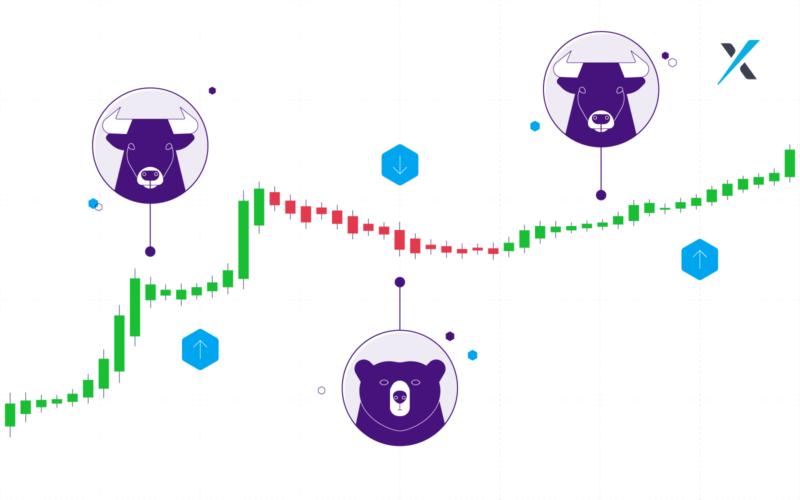If you’ve been trading cryptocurrencies, you’ve probably come across the terms “bear market” and “bull market“. Don’t worry, it’s understandable to get confused when you hear these terms—what do bears and bulls have to do with cryptocurrency?
The truth is, the bull and bear markets have tremendous effects on investor mindsets. But first, let’s define what these markets are and how to distinguish what type of market you’re in.
What is the bear market?
A market turns “bearish” when there is a substantial market downtrend over a relatively short period. Basically, it’s when you see that the prices start to rapidly drop.
Some say that a market can be classified as a “bear market” once it sees a 20% dip over 60 days (or more). That 20% figure is mostly arbitrary and trends are sometimes not that obvious. To recognize the less obvious bearish patterns, many analysts use numerous tools and systems.
Bear markets are often caused by slowing economies—this means economies that have low employment, disposable income, business profits, or, generally, weak productivity.
What is the bull market?
Bull markets are the opposite of bear markets. They feature upward trends over short periods. These markets are often characterized by optimism among investors, as they bring expectations of prices to rise.
During a bull market, investors are more confident as they often expect reliable results continuing over extended periods (despite it being difficult to consistently predict trends).
Bull and bear markets in the context of cryptocurrency
Although these two terms were mainly applied in traditional markets, they’ve found their way into cryptocurrency markets as well. However, cryptocurrency markets are smaller and more volatile, making it more common to see a substantial and extended bear or bull crypto market.

The origin of the terms
The meanings of these terms are simple enough to understand—bearish for a downward trend, bullish for an upward trend. But if you’re like us, you’re probably wondering why they’re named that way. Both animals are great representations of strength and power, but why is a bear used for the downward trend while a bull is used for upward patterns? There are two answers to this question, both of which are often used to explain their origin.
The first is a historical explanation. In olden times, there were middlemen for the merchants that sold bearskins. These middlemen would then speculate on the future prices of these skins, hoping that trappers would sell it to them at a lower cost (mainly hoping for the price to drop). The middlemen became known as “bears” and that term stuck for a downturn in the market—something these “bears” hoped for. On the other hand, bulls were very well considered to be the opposite of bears because of a popular bloodsport that pitted bulls against bears. As a result of bulls being opposite to bears, the term stuck for an upward trend.
The second explanation has something to do with the way each beast attacks. Bears swipe down with their paws, while bulls thrust upwards with their horns—and depending on who you ask, it’s as simple as that.
Taking advantage
With all that said, there are ways to use both kinds of markets to your advantage. The fact that bear markets portray downward trends doesn’t necessarily mean there aren’t opportunities to make money.
But first, let’s talk about taking advantage of a bull market. Generally, investors will take advantage of bullish markets by getting in early, using the rising prices to make a quick buck and leaving the market as soon as the asset has reached its peak. No one has a definite answer as to when the market reaches its peak. Still, if you observe your investment carefully, losses may be minimal and usually temporary.
If it seems like things are going crazy and you sense a bearish trend coming, you might want to reduce your positions—especially if you have positions in lesser-proven cryptocurrencies. At this point, it might be best to move your holdings into other assets like cash or precious metals. These types of assets may be able to hold their ground against a crash and might also put you in a good position for the incoming bear market. At the end of a bull market, many quality cryptocurrencies may be available at low prices, giving you the possibility of doubling (or even tripling) investments.
Taking advantage of a bear market is a little more complicated. Investors will often make use of a strategy called short-selling. This strategy involves selling borrowed shares in the hopes of repurchasing them at a lower price. However, this is an extremely risky trade and it should only be done by experienced traders.
Bull vs. bear market
As mentioned earlier, there are money-making opportunities in both kinds of markets—so don’t take out too much on the bear. The critical thing to take note of is that strategies differ significantly for each market. You must know what type of market you’re in so that you know which trading strategy to implement.
As with any investment, cryptocurrency investment is always going to be a risk. To minimize these risks, make sure to do your homework and never invest money you aren’t willing to lose. Digital assets like cryptocurrencies are still in their infancy stages, maturing as we go along. They can be incredibly volatile and not for the faint of heart.
In this arena, knowledge truly is power. Doing your own research will help you minimize all the possible risks. Read blogs, watch videos, and join forums—trust us, it helps. And when you finally get the hang of it, you’ll see that it’s quite a ride.
*The content of this article is for informational purposes only, you should not construe any such information or other material as legal, tax, investment, financial, or other advice.